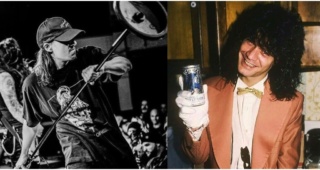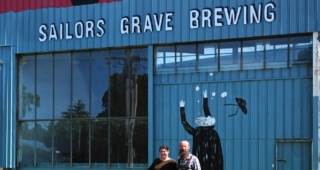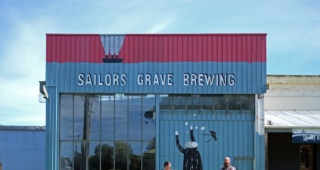This is a story of a long-forgotten London brewery resurrected on the other side of the planet almost 100 years after it passed out of existence, first due to acquisition and new ownership, and then once and for all by fire. Or so it seemed.
Built on the South Bank of the River Thames in the booming 1830s, a time when London reigned supreme as the world’s most populous city and most powerful trading port, Lion Brewery is today largely relegated to marginalia in the telling of UK brewing’s illustrious tale. It does not quite compare in historical prestige to, say, such London peers as Whitbread Brewery—at one time the largest of its kind in the universe—Barclay Perkins Brewery, or George Hodgson’s Bow Brewery, which (along with other breweries) played a key role in helping popularize an emerging beer style called the India Pale Ale.
Lion certainly did something right, however. At one point there were around 90 Lion Brewery Co pubs across London, and Lion brewed for nearly 90 years before founder James Goding sold the place in 1924 to Hoare and Co, one of the city’s oldest breweries. The brewery was ravaged by fire in 1931, fell into ruin, and demolished in 1949 to make way for Royal Festival Hall. (It’s too bad for the descendants of Mr. Goding that the man’s repeated attempts to convert the brewery’s prime chunk of land into freehold ownership were repeatedly denied.)
Before the brewery was reduced to rubble, King George VI asked that the largest of its three signature lion statues be saved. In the end two of the statues survived, both of which today command prominent perches in key areas of London. The lion spared by royal decree stands at the south side of Westminster Bridge; its smaller counterpart, now gilded in gold, looks out from atop the Rowland Hill Memorial Gates of massive Twickenham Stadium, the home of England rugby.
It is a combination of these lions—the gleaming golden coat of the latter applied to the stately shape of the former—that graces beer bottles from rebooted Lion Brewery, which a trio of homebrewer expats (two of them British) unveiled in Singapore in late 2018. “When you look at pictures of the London skyline from 150 years ago there’s this huge building, the brewery, with a lion looking over the city, and there were wharfs of the River Thames right in front of it used to load the beer barrels onto the ships,” says co-founder Harry Renshaw. “We came to Singapore, one of the most famous trading ports there is, and just thought it was a really cool connection. We liked the idea of relighting a story like that.”
Locals, of course, know the linguistic association between Singapore and this London brewing relic. But for those unaware, Singapore is often called the Lion City, a nickname drawn from the republic’s ancient Malay name Singapura; in Malay, “singa” means lion and “pura” is city.
Locked Down, But Not Out
Following an extended period of stagnation in local craft brewing, Singapore has in recent years experienced a relative tidal wave of upstart brands wade into a market previously (and still) dominated by imports. Some invested in brewing facilities, including one-time Beer Travelist collaborators Rye & Pint and Pink Blossoms Brewing, but most are contract brewers, or “gypsy brewers” if you prefer the sexier term for brands that brew the beers at a host facility.
The reasons to contract brew are fairly obvious—lower up-front investment, lower costs, lower risk. It also allows those brands planning to potentially sink cash into a brewery an opportunity to first get their name out there, and see what works (and what doesn’t), before diving into the deep end.
Speaking by Zoom in these locked-down, socially distanced times, Renshaw says that’s the idea for Lion Brewery, which brews up to 10,000-liter batches at a time at Kingdom Breweries in Phnom Penh, Cambodia. “We want a brewery, or even more than one, but strategically the approach we’ve gone for is to focus on distribution and brand recognition before spending money on the steel,” he says. “As a result, right now our overheads are quite low, relatively speaking.”
That’s proven to be a particularly fortuitous decision given the swift and crippling economic impact of the Covid-19 pandemic in Singapore and elsewhere in Southeast Asia. The republic is plunging into what looks like prolonged recession, and following an overall decline in F&B sales during the first quarter of this new decade, so-called “circuit breaker” measures the government enacted on April 7 put further stress on the industry. Until at least June 1 many F&B and retail venues are closed, and those offering craft beer that do remain open only serve via delivery or takeaway.

Prior to the lockdown circuit breaker, Lion Brewery’s two core beers, the 4.7% Island Lager and 4.5% Straits Pale Ale, were available at more than 100 bars and restaurants in Singapore. “Luckily we’re in a great position. We have web sales and obviously we’ve been focusing on that, but we’re conscious to not have it be all about that,” says Renshaw. “In reality the bars are going to come back, so we’re talking to them every day and asking them how we can work with them. This is an opportunity to step back and look at all these things.”
Three’s Company
These things include the beer itself.
Lion Brewery relaunched with the pale ale, a beer akin to the first album a band had its entire life to create. Renshaw and co-founder Benjamin Hendry-Prior spent years tinkering with it, trotting it out to parties as homebrewers do until settling on the current recipe. It only employs Citra hops, which impart a pleasant tropical fruit aroma and flavor that mingles well with a four-grain malt bill. It’s easy to overdo it with Citra—and depending on the beer it’s sometimes fine when that happens—but Straits Pale Ale benefits from restraint.
“We’d been trying to make what we thought would be the perfect beer for Singapore. We were brought up on ale in Britain—you know, warm and flat beer that doesn’t work so well out here because it’s so hot—so the idea was kind of an ‘ale-ish’ sort of beer that was a bit more floral, with dry hops to really give it a more tropical fruit-type thing,” Renshaw explains. “We’d be very happy if people described our pale ale as like a gateway drug that gets people on to craftier beers from more mainstream lagers.”
Island Lager has been more of a real-time experiment. Ngak Hwee Ng, a Certified Cicerone and Lion Brewery’s sales executive, says the recipe changed four or five times, but that paring down the malt bill and single-hopping with Hallertau Blanc in the most recent batch is the approach likely to stick. “Initially we used Vienna and Pilsner malts, Hallertau for bittering, and Simcoe for dry-hopping to make it kind of like a hopped lager,” says Ng over Zoom. “The beer tasted nice and was interesting, but we sort of tried a bit too much. Now it’s more like a dry, German-style Pilsner.”
Related: In Bermondsey, a Belgian State of Mind at The Barrel Project
Lion Brewery’s third beer, released in April, is a marked departure from the sessionable flagships. Brewed in collaboration with London Beer Factory at its brewery in south London’s Gipsy Hill area, Nutmeg Singapore Stout is a sweet 7.5% pastry stout brewed with handpicked nutmeg, Madagascan vanilla, and bourbon-soaked cacao nibs. Renshaw says it’s partly a homage to the milk stout the old Lion Brewery once brewed, and at the same time a nod to the brewery’s reinvention.



“We wanted to show that we’re up for doing different, wacky things, and liked the idea that nutmeg was this major economic driver for Singapore,” he says. “I picked it from a tree in our garden, filled a bloody bag of the stuff, grated it up… I had no idea how much to put in. That was one of the other things behind this beer, as well, the idea of getting the nutmeg from Singapore, taking it to London, brewing the beer, and then shipping the beer back to Singapore.”
Balancing Act
Even as Ng and Renshaw emphasize Lion Brewery’s core mission to brew beers catered to Southeast Asia’s hot and humid climate, I get the sense they both itch to expand Lion Brewery’s repertoire. Ng, a musician who pulled part-time shifts at various craft beer bars around town before joining Lion, practically coos while discussing the brewery’s nutmeg stout, calling it his favorite Lion beer and noting how much he loves imperials. Renshaw says the brewery’s next beer is likely to be a New England-style IPA “because we just love them so much.”
Business is business, however. Things like hazy IPAs, pastry stouts, and other such styles are certainly all well and good and welcomed, but the relatively small communities of dedicated craft beer enthusiasts in the region pale in comparison to the craft-curious beer drinkers likely to start (and stay) on the lighter, more accessible spectrum of craft. Breaking out of the bubble, craft beer education, climate-appropriate beers—these are already well-worn topics in Southeast Asia’s beer world, but ones that are still as applicable and essential as ever.

“One of the reasons for this wave of new breweries in Singapore is they’ve got the benefit of observing North America, Western Europe, and Australia, places where [craft beer] sort of crests and then falls down,” says Renshaw. “People get into these really different, wacky beers, and then after a while kind of say that’s all brilliant, but I don’t want to drink that all the time. I want my go-to beers. Ultimately it’s about fulfilling the needs of people.”
Hoppy Trails
Rooted in travel, adventure, and, well, British colonialism, the history of India Pale Ale is a fascinating one that warrants far more elucidation than we offer here.* In short, IPA first became a thing in the late eighteenth century, when English brewers developed massively hopped ales designed to withstand the long journey in wooden barrels from Britain to India, where it was accepted with delight by soldiers who, shall we say, enjoyed their booze.
Arriving in that first IPA heydey, Lion was one brewery that engaged in the 18,000-mile beer trade. With Renshaw soon relocating to London to set up some brewery operations there, it sounds like Lion may do something like it again. “We really like the idea of doing an IPA that represents the original, and that’s one of the things I’m going to do in the UK,” he says. “The hope is to put it in barrels and age it at sea on the way to Singapore. There’s a lot of stuff we can do there.”
###
All photos courtesy Lion Brewery.
Full Disclosure: Lion Brewery sent us a complimentary mixed six pack to drink and discuss during our Zoom chat. While this did not influence our coverage, Beer Travelist believes in transparency.
* For a deep, entertaining dive into the history of IPA, we recommend Pete Brown’s Hops and Glory, which centers on Brown’s attempt to recreate the journey of an IPA from the UK to India.





